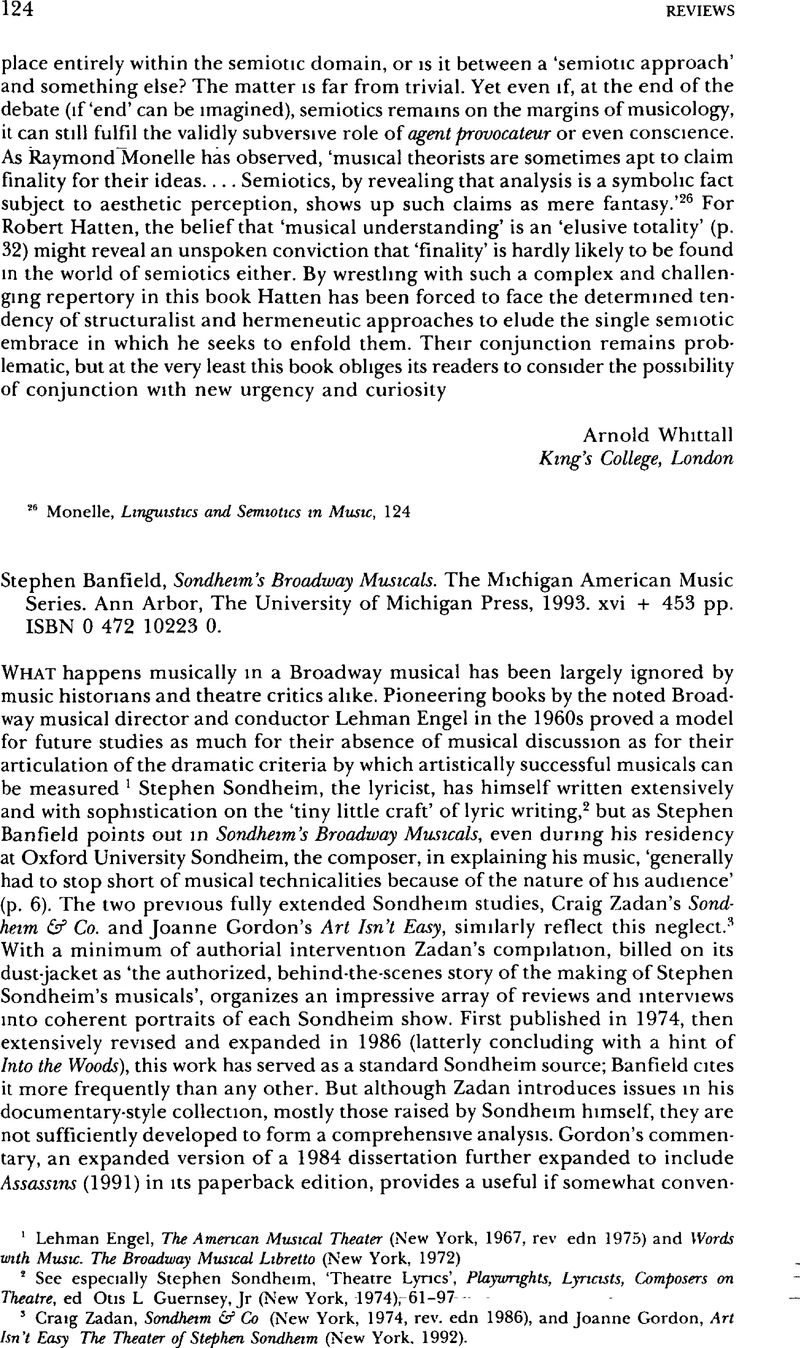No CrossRef data available.
Published online by Cambridge University Press: 01 January 2020

1 Engel, Lehman, The American Musical Theater (New York, 1967, rev edn 1975) and Words with Music. The Broadway Musical Libretto (New York, 1972)Google Scholar
2 See especially Stephen Sondheim, ‘Theatre Lyrics’, Playwrights, Lyricists, Composers on Theatre, ed Otis L Guernsey, Jr (New York, 1974), 61–97.Google Scholar
3 Zadan, Craig, Sondheim & Co (New York, 1974, rev. edn 1986), and Joanne Gordon, Art Isn't Easy The Theater of Stephen Sondheim (New York. 1992).Google Scholar
4 On numerous occasions Banfield makes a strong case for the dramatic significance of Sondheim's accompaniment figures, which along with verbal notes constitute the ‘two common starting points to the creation of a Sondheim song’ (p 62).Google Scholar
5 Swain, Joseph P, The Broadway Musical A Critical and Musical Survey (New York, 1990)Google Scholar
6 Engel, The American Musical Theater, 154.Google Scholar
7 Block, Geoffrey, ‘The Broadway Canon from Show Boat to West Side Story and the European Operatic Ideal’, Journal of Musicology, 11 (1993), 525–44Google Scholar
8 Diegetic songs such as ‘Honey Bun’ (South Pacific) are rare in the operettas that established and continue to maintain Rodgers and Hammerstein's initial popularity and sustained reputationGoogle Scholar
9 Banfield, Stephen, ‘Book Nook II’, Institute for Studies in American Music Newsletter, 20, no 2 (May 1991), 6Google Scholar
10 See Martin, George, ‘On the Verge of Opera Stephen Sondheim’, Opera Quarterly, 6, no 3 (spring 1989), 76–85, and Harold C Schonberg, ‘Why Isn't a Musical Comedy an Opera5’, New York Times, 21 November 1979, repr in Facing the Music (New York, 1981), 254–8CrossRefGoogle Scholar
11 Zadan, Sondheim & Co., 156–7Google Scholar
12 Swain, The Broadway Musical, 11Google Scholar
13 Kerman, Joseph, Opera as Drama (New York, 1956, rev edn, Berkeley and Los Angeles, 1988).Google Scholar
14 Kivy, Peter, Osmin's Rage. Philosophical Reflections on Opera, Drama, and Text (Princeton, 1988)Google Scholar
15 Ibid., 258Google Scholar
16 For a spirited defence of Mozartian comedy on ideological and aesthetic grounds, see Wye J. Allanbrook, ‘Mozart's Tunes and the Comedy of Closure’. On Mozart, ed James M Morris (Cambridge, 1994), 169–86Google Scholar
17 Swain, The Broadway Musical, 205Google Scholar
18 Ibid., 243.Google Scholar
19 Ibid., 244–5Google Scholar
20 Bernstein, Leonard, ‘Excerpts from a West Side Story Log’, Findings (New York, 1982, repr 1993), 147 (6 January 1949)Google Scholar
21 Swain, The Broadway Musical, 320Google Scholar
22 Ibid., 351–2.Google Scholar
23 Ibid., 354.Google Scholar
24 Quoted in Martin, ‘On the Verge of Opera’, 83.Google Scholar
25 Ibid., 84Google Scholar
26 Blyton, Carey, ‘Sondheim's Sweeney Todd – The Case for the Defence’, Tempo, 149 (1984), 19–26, and John Rockwell, All-American Music Composition in the Late Twentieth Century (New York, 1983), 209–20Google Scholar
27 Other criticisms confront a work directly rather than distilled through Sondheim's subsequent written comments. In one such penetrating assessment, Banfield, after listing the songs that feature the ubiquitous downward seventh in the revered Into the Woods, concludes that ‘the effect of such widespread use is to minimize the distinction between them’ (p 401)Google Scholar